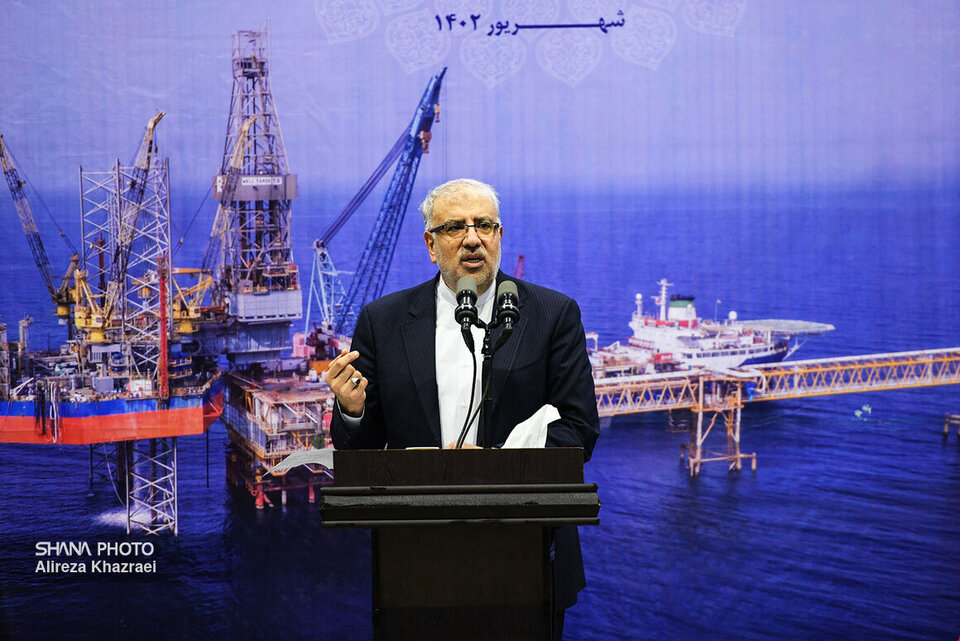Delivering speech at the Phase 11 inauguration ceremony attended by President Seyyed Ebrahim Raeisi in Assaluyeh, southern province of Bushehr, the minister underlined that the SP file is not closed as it is now important to maintain production and boost pressure in the joint field.
“This is the second time the president has visited Bushehr Province since six months ago to inaugurate the oil industry’s projects,” said Owji, adding President Raeisi was in Assaluyeh in March 2023 to launch the refinery of SP Phase 14, which added 56 million cubic meters to the country’s daily gas processing capacity.
Today, Phase 11 was officially put into operation while foreign companies, including Total, Shell, and China National Petroleum Corporation (CNPC) did nothing for its development in the past 20 years, he mentioned.
The development project of SP Phase 11 was implemented through great efforts made in the past 20 months by the National Iranian Oil Company (NIOC), Pars Oil and Gas Company (POGC), Petropars, and the Iranian Offshore Engineering and Construction Company (IOEC) with support of the government, he explained.
Total had signed a contract worth some $4.8 billion with Iran to develop Phase 11, but the French company quit due to sanctions in 2018, recalled Owji, adding the project was resumed under Iran’s 13th (incumbent) administration and inaugurated today.
Phase 11 gas output to exceed 50 mcm/d
Owji said gas production in Phase 11 of South Pars field will surpass 50 million cubic meters per day (mcm/d) when all wells are drilled and completed.
The Oil Ministry put the completion of semifinished projects on the agenda since the 13th administration took office in August 2021, he underlined.
According to the minister, 34 semifinished projects worth $12 billion became operational by the end of the past Iranian calendar year – March 20, 2023 – and the number of upstream and downstream projects to be completed by March 19, 2024 will reach 67.
Out of 67 semifinished projects worth $15 billion, 25 valued at $7.5 billion have so far come on stream, he added.
Furthermore, he continued, executive operations of 15 new projects will start this year.
10 important measures in SP field
The oil minister said the 13th administration has taken 10 important measures in the South Pars gas field.
Naming some of the plans, he pointed to inauguration of SP Phase 11, launch of gas condensate sweetening plants of phases 2 and 3, construction of new pipeline for SP Phase 16, inauguration of refinery of SP Phase 14, launch of the second phase of Abadan Refinery with a daily capacity of 210,000 barrels, inauguration of associated petroleum gas (APG) collection project, and inauguration of Hoveyzeh Gas Refinery.
It would take three to four years to build a platform for SP Phase 11, said Owji, adding, “We managed to start production in Phase 11 four years earlier by moving and installing a platform, leaving former contractors Total and CNPC bewildered.”
The country has become self-sufficient in developing oil and gas fields, drilling offshore and onshore wells, and horizontal drilling.
No foreign adviser in Iran
No foreign adviser is now present in upstream and downstream sectors of Iran’s oil industry, emphasized Owji.
Thirty countries are on the U.S. sanctions list and their oil production has been reduced and their refineries have come to a standstill, the minister mentioned, adding, “Iran, however, not only has become self-sufficient in oil industry, but also has implemented refinery projects overseas.
“Then U.S. President Bill Clinton's D'Amato Law – the trade embargo against Iran – was believed to paralyze Iran’s oil industry, but the country’s daily oil and gas production capacities have now reached 3.8 million barrels and over one billion cubic meters, respectively.”
Touching upon progress made in the petrochemical sector, he said Iran’s annual petrochemical production capacity now stands at 92 million tons, adding petrochemical exports fetched the country $16 billion in the previous year.
The country’s daily refining capacity of oil and gas condensate refineries equals to 2.3 million barrels, Owji concluded.


Your Comment